3 design lessons from Ghost Beacon
Exploring how the design of Ghost Beacon for the One-Page RPG Jam taught me some lessons about game design. Keeping good notes, feedback on what's (not) fun, and using project management tools.
It’s safe to say that I think about the One-Page RPG Jam almost all year long.
Although I do not run the jam and it is in no way affiliated with Exeunt Press, it has been an important and consistent source of inspiration for me. Seeing the positive response to Exclusion Zone Botanist (which began as a one-page trifold) was extremely motivating! So much so that I wrote Make Your Own One-Page RPG to encourage others to try their hand at making small, weird, games.
With this year’s entry submitted, there are some important design lessons learned that I wanted to share.
Ghost Beacon
The Exeunt Press entry for this year’s jam is Ghost Beacon, a solo space archaeology journaling game:
Gliese 667-Cf is a tomb. Baked by a dying sun, the civilization that inhabited this planet has perished. Their buildings and monuments lie in ruin. Their culture buried under dust and sand. In an effort to be remembered, they have left behind beacons, beaming signals to whoever might hear them beyond the stars.
You are a xenoarchaeologist following the beacons, recovering artifacts, and attempting to tell the story of this lost civilization. It is a race against a coming geologic cataclysm with new faults forming — destroying artifacts and potentially blocking your path. Gather what you can, return to your ship, and leave.
Using what you have observed and recovered, tell the story of the lost civilization.
Free community copies are available during the game jam ending August 17, 2025.
Lesson 1: Write it down.
In early March, just after a final checklist and notes for Tumulus, I scribbled some game idea notes in my main notebook. Scrawled across the top was “Eleventh Beast in spaaace!” and “Game Idea” circled, followed by notes and bullet points for features to include and exclude:
Planet map. Multiple planet maps? Travel between planets?
Beacons/signals vs. rumors. Something of lost civilization?
Collect and return to ship. Why collect? Epilogue?
Robots for solo play? Multiplayer? Classes?
No cards! Only d6 dice!
Two pages of notes like this — fragments of ideas and contradictions. It also includes a list of potential titles: Carrier Wave, Signal Lost, Final Signal, Silent Signal, and so on. I was apparently quite fond of using the word signal in the title.1 There’s a scribbled point crawl map with notes on how to use some dice with it.
In the end, Ghost Beacon looks almost nothing like those notes. It uses a grid map rather than a point crawl. I suppose there is some connection between the appearance of beacon and the rumors in Eleventh Beast, but it is tenuous at best. There is decidedly no combat — the threat of the planetary catastrophe is unstoppable. It even uses a deck of cards when the notes specifically urged against it.
Having those notes, however, allowed me to take that idea and grow it into a full game during the jam. Not in a way that was beholden to the notes as something that must be obeyed, but rather as a spark.
The final game is slower, more contemplative, and more open-ended than the game the notes described. As you drive your rover across the planet’s fractured surface, you are observing points of interest and collecting artifacts for later analysis. It ends not in a battle, but in important questions: What caused the rise and fall of the civilization? What were its accomplishments, mistakes, triumphs, and tragedies? What mysteries remain buried on the planet to be lost forever?
So that’s the first lesson: Write down your ideas. Keep them ready for when you need some inspiration, but don’t feel like you have to follow them like a recipe.
Lesson 2: Not never… just not now.
One of the biggest challenges when creating a one-page game is scope creep — the unlimited addition of new features and mechanisms during a game’s design.2
With limited space (1-2 A5 pages), there just isn’t room for a lot of features. Assuming you want to add some cover art, back cover description and credits, and some random tables, there just isn’t room for many mechanisms.
In the case of Ghost Beacon, I solved this by forcing myself to use a parking lot — a method I use when running meetings to keep them on track. When an idea or topic is brought up but just doesn’t fit into the narrow scope of the current meeting, I acknowledge it and write it down for later. The parking lot is visible for all to see, usually on a whiteboard. This allows us to stay on topic, finish on time, and yet not forget that valid (potentially unrelated) topics still exist.
As I worked on the core game loop, there were so many cool idea I wanted to build into it. Unfortunately, the whole thing had to fit onto effectively a single panel of an A5 trifold brochure. That meant that many of those ideas (as valid as they were) had to be cut. Rather than trash them, I wrote them down in the parking lot.3
This allowed me to keep working on the core game, get it finished, and not get bogged down by agonizing over removing something fun but complicated. Using the parking lot trick on myself allowed me to finish a timely manner.
That’s the second lesson: Beware scope creep and use project management tools like the parking lot to keep it under control.
Lesson 3: But is it fun?
In an early version of Ghost Beacon, I wanted to emphasize the risk of being trapped on the planet if you didn’t make it back to your ship in time. Mechanically, this meant that there was a risk of just being swallowed up by a fault if it happened to appear at your rover’s location or your ship’s location — immediately ending the game. You’d possibly get one last chance to tell the civilization’s story, but any artifacts would go unanalyzed and couldn’t be used. I thought it was thematic, if harsh.
All three of my early playtesters loved the game, but didn’t like that specific part of it. They called it out as a potentially “not fun” part of the game, some with some suggestions on how to fix it.
I struggled with it a bit, trying to add more context and mechanical bits to make it better. That resulted in more rules, explanations, and it no longer fitting into the layout. At that point, I realized they were right.
Thematic design is important, but not to the point that the game stops being fun. Even if it is an edge case that rarely pops up, the game still needs to support the kinds of fun that are part of the promises made by the game.
I moved some of the harsh elements to the parking lot and changed the section. The final version still retains consequences but doesn’t stop the player from playing. It’s far better than the original, and I’m extremely grateful for their honest feedback.
The third and final lesson: When everyone feels part of your game isn’t fun, they might be right. Fixing it doesn’t necessarily mean adding more and more stuff.
Conclusion
Some things to think about:
Keep good notes: It doesn’t matter if you use a paper notebook, Notion, or the notes app on your phone. Reduce the barrier to writing down ideas as you have them and before they are forgotten. You’ll develop a pile of ideas, ready to use when you need them. Just don’t worry about following them to the letter!
Consider an expanded version: Caveat Emptor has both a simple trifold version and an expanded zine that includes rules that didn’t fit in the one-page format. Using the parking lot for Ghost Beacon allowed me not only to capture these ideas, but they are immediately organized in a way that can be used to make the expanded edition.4
Don’t keep adding more and more: People are more likely to choose additive solutions over subtractive ones. That applies to game designers as well! My first instinct was to add more mechanisms to respond to the early feedback, when the right answer was a subtractive solution.
Grab a free community copy of Ghost Beacon during the game jam. The One-Page RPG Jam ends August 17, 2025 and already has over 400 submissions, most of which are free to play. Check them out!
— E.P. 💀
P.S. “A beautiful, straight-forward, and inspiring book.” Get ADVENTURE! Make Your Own TTRPG Adventure, the latest guide from Skeleton Code Machine, now at the Exeunt Press Shop! 🧙
Skeleton Code Machine is a production of Exeunt Press. All previous posts are in the Archive on the web. Subscribe to TUMULUS to get more design inspiration. If you want to see what else is happening at Exeunt Press, check out the Exeunt Omnes newsletter.
Skeleton Code Machine and TUMULUS are written, augmented, purged, and published by Exeunt Press. No part of this publication may be reproduced in any form without permission. TUMULUS and Skeleton Code Machine are Copyright 2025 Exeunt Press.
For comments or questions: games@exeunt.press
I do try to avoid duplicating titles of other existing works and will usually do some searches before settling on a title. It turns out almost all variations of “signal” were taken, already used, or associated with other video games, books, or movies. Eventually I settled on Ghost Beacon which I think is better than any of those original ideas anyway.
A distinction can be made between scope creep and feature creep. Both describe similar problems (i.e. uncontrolled growth), but one operates at the project level and the other at the product level. You could certainly make the case that what I’m describing is feature creep, but I prefer the project management scope creep terminology.
In this case, a list at the bottom of the Notion page where I was working.
I intentionally called the one-page version Ghost Beacon One-Page Micro Edition because I plan to release the full version later this year. There are some really fun ideas in that parking lot that I want (need) to see in the full game.

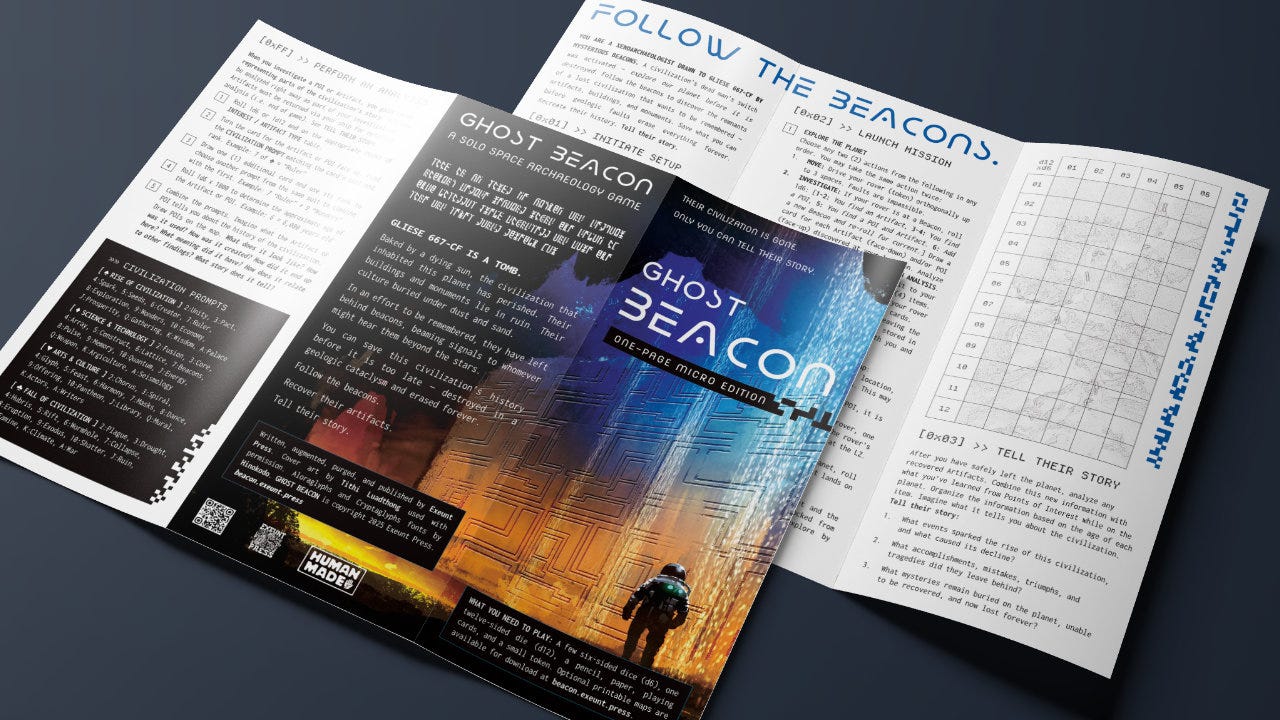
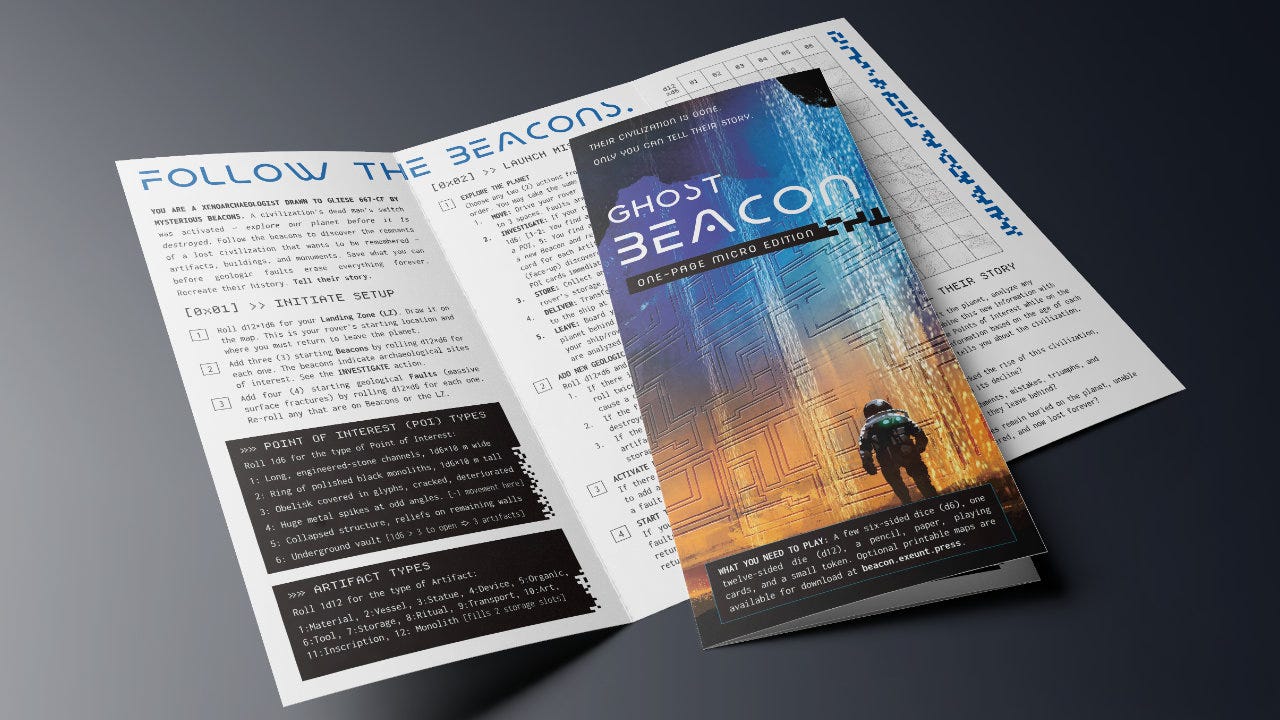
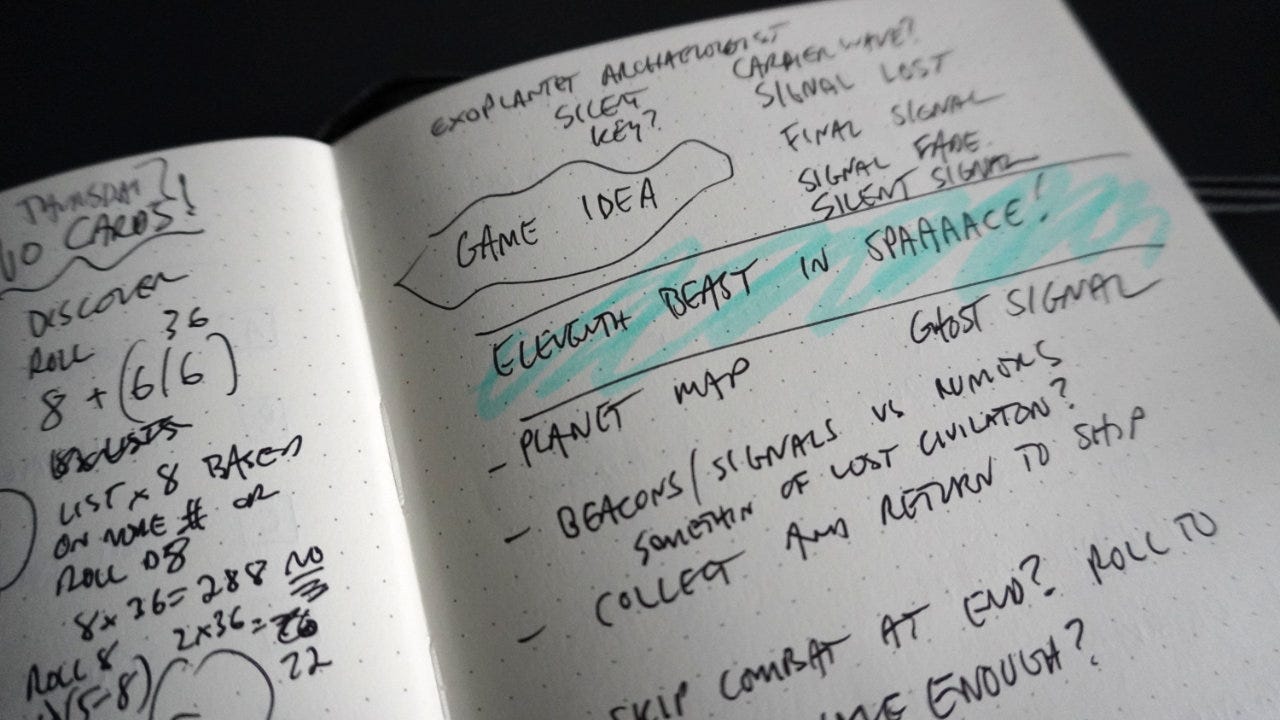
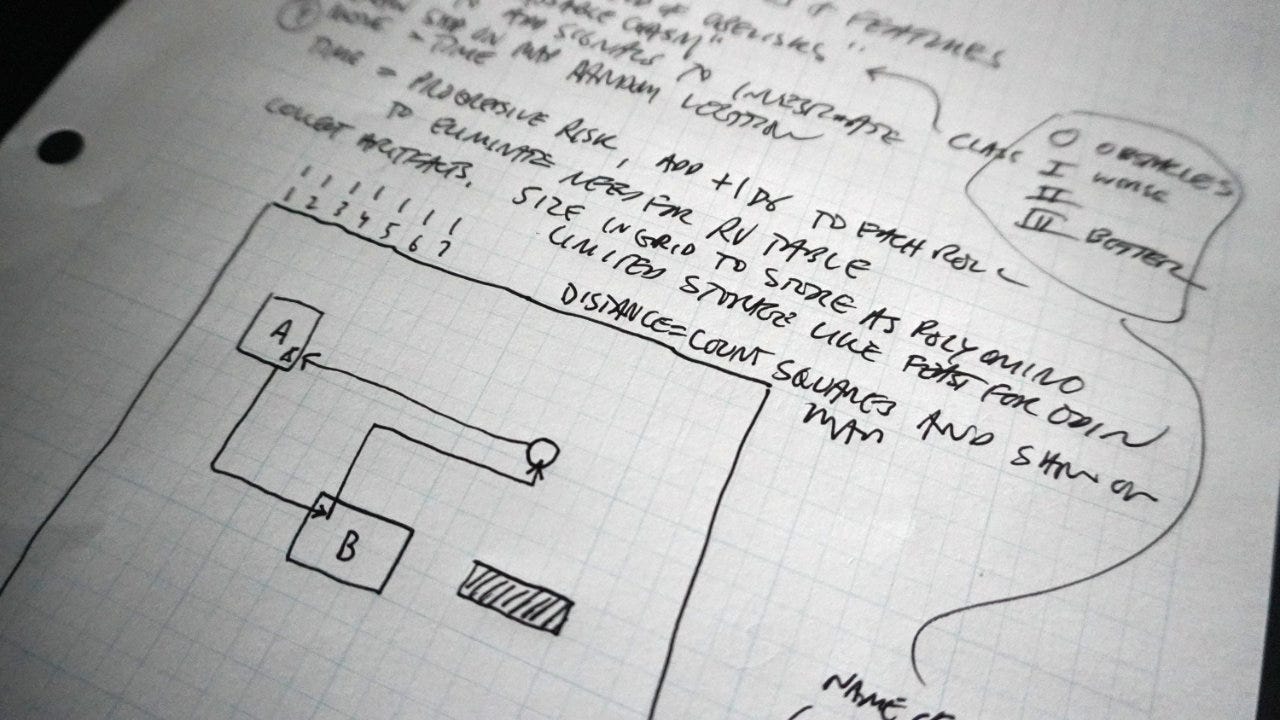
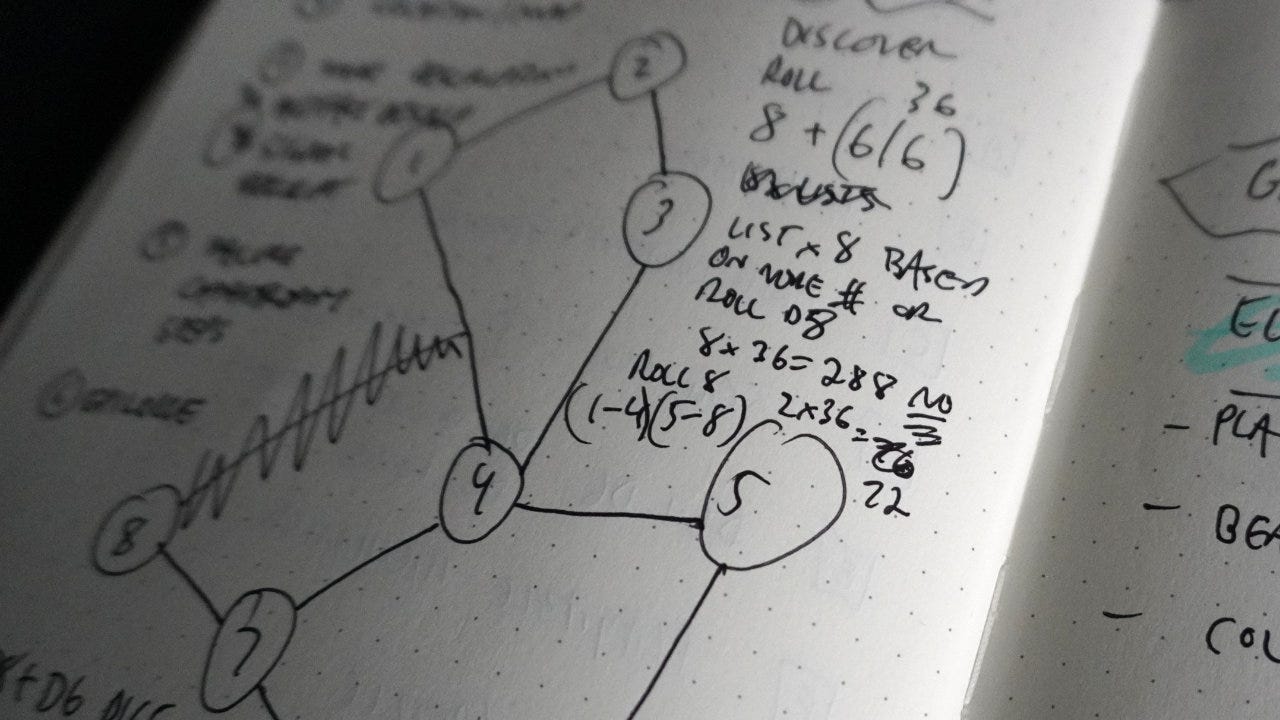
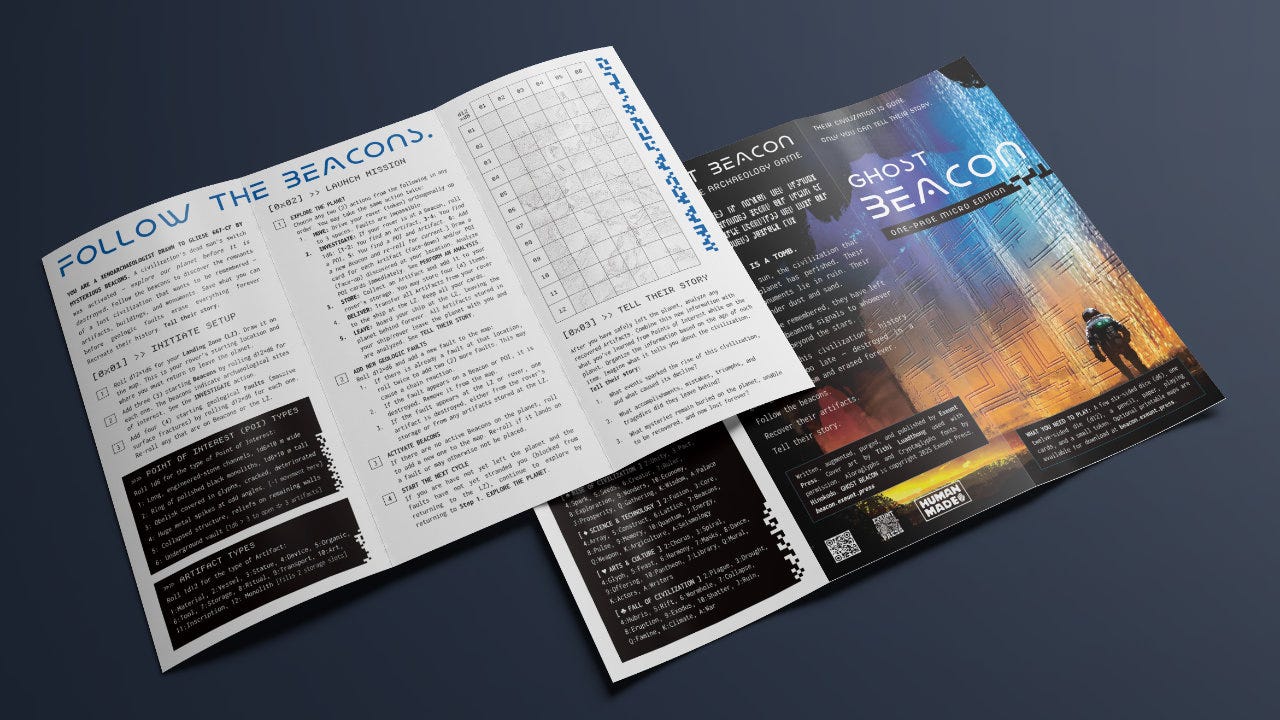
Thank you for sharing you're design lessons. They are very helpful and insightful.
Hello! I just wanted to say a quick thank you for introducing the concept of one-page rpgs to me. I first learned about them in your analysis of Lacksmith (excellent game), and I got really excited at the idea of making a game that was mechanically satisfying but simple enough to fit on a single page. My submission to this year's One-Page RPG jam (which you can find here if you're interested: https://gus-the-gamesmith.itch.io/desperate-dating) is a direct result of your newsletters, so I'm very grateful! I'm going to print out Ghost Beacon today, and I'm certain that I'll enjoy it thoroughly :)